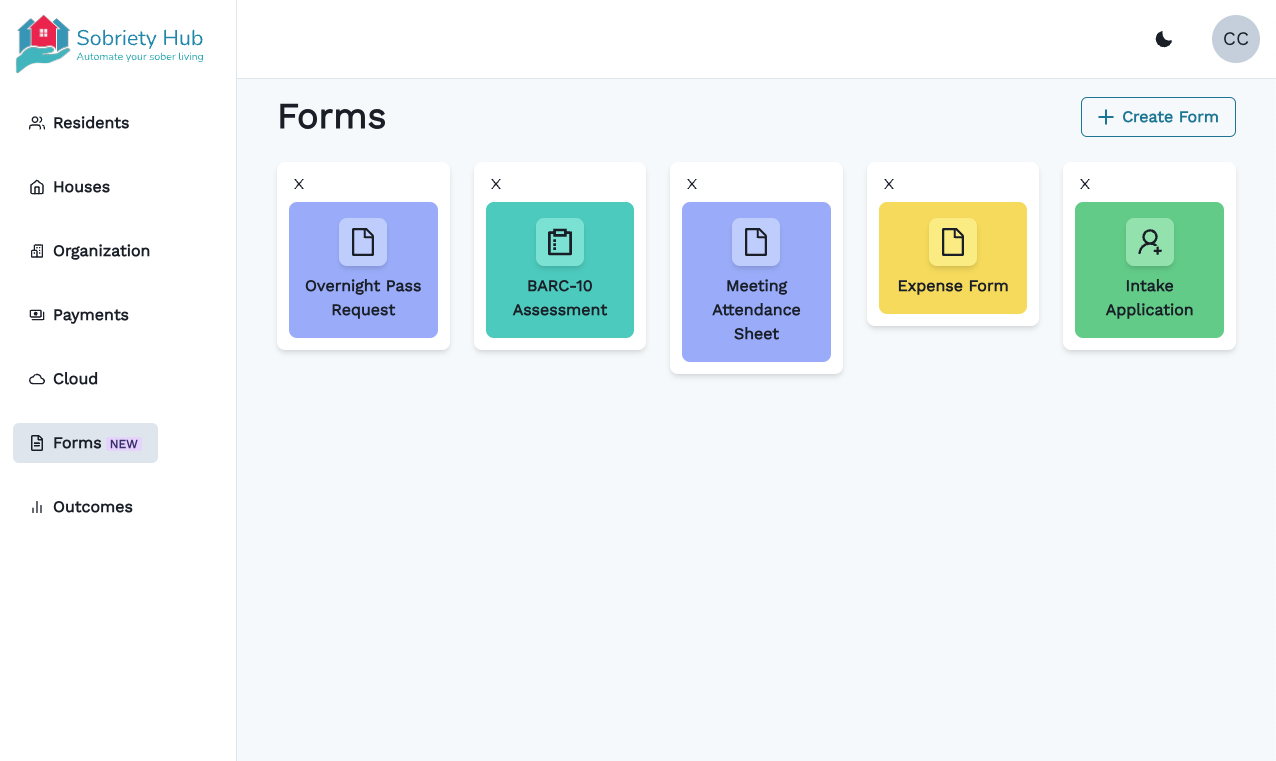6 Steps to Win Grants for Your Recovery Housing Program in 2026
The funding landscape for recovery housing just changed overnight. HUD announced policy changes that redirect the majority of CoC funding from permanent housing to transitional housing and supportive services, with applications closing January 14, 2026 Smart Cities Dive. Meanwhile, SAMHSA awarded more than $45 million in supplemental funding to expand recovery housing services for young adults SAMHSA.
Translation: Billions of dollars are now flowing toward exactly what you do.
But here's the catch that most operators miss: the new funding approach requires 70% of CoC projects to compete, and limits CoC funding for permanent housing to 30% National Low Income Housing Coalition. Success now depends entirely on one thing—proving your program works with clean data.
This guide gives you the 6 essential steps to position your recovery housing program for funding success in 2026, where outcomes aren't optional—they're everything.
Before You Start: Prerequisites
Most grants require these fundamentals in place:
✅ Property secured (owned or leased with documentation)
✅ 501(c)(3) nonprofit status (for most federal and foundation grants)
✅ Complete business plan and budget
✅ Outcomes tracking system (NEW critical requirement)
✅ NARR certification or state equivalent (increasingly required)
Can't check all these boxes? Start with what you have and build from there. But prioritize getting an outcomes tracking system in place immediately—it's now the difference between winning and losing grants.
Step 1: Research and Target the Right Funding Sources
The funding landscape just exploded with opportunities. Here's where to look:
Federal Funding (The Big Money)
🎯 HUD Continuum of Care (CoC) Program — TOP PRIORITY
- $3.9 billion available for 2026
- Applications close January 14, 2026 Smart Cities Dive
- Awards: $2.5M - $25M per project
- Action: Contact your local CoC coordinator THIS WEEK
🎯 HUD Recovery Housing Program (RHP)
- State-administered funding specifically for recovery housing
- Up to $750,000 per project
- Indiana deadline: December 21, 2025 & February 22, 2026
- Check your state's allocation: HUD RHP Info
🎯 SAMHSA Recovery Housing Grants
- $45 million for young adult recovery housing (ages 18-24) SAMHSA
- State Opioid Response (SOR) supplemental funding
- Browse opportunities: SAMHSA Grants
🎯 DOJ Second Chance Act
- Bureau of Justice Assistance grants
- Reentry and transitional housing for justice-involved populations
- Search: Grants.gov
State & Local Funding
State Sources:
- State housing authorities (RHP allocations)
- Opioid settlement dollars (advocate for recovery housing use)
- State behavioral health agencies
- State NARR affiliates
Local Sources:
- Local CoC coordinators (desperate for transitional housing partners)
- County behavioral health departments
- City homeless services departments
- Community Development Block Grants
Private & Foundation Funding
- National foundations via Charity Navigator
- Community foundations via Council on Foundations
- Faith-based funding (NEW preference under Executive Order 14321)
- United Way Community Impact Grants
Alternative Funding
- Scholarship programs: Fund Recovery, Clean Cause Foundation
- Outcomes-based contracts with local governments
- Performance-based payment arrangements
Pro tip: Every conversation should end with "Who else should I contact?" This exponentially expands your network.
Action Steps This Week:
- Contact your local CoC coordinator at HUD Exchange
- Check your state's RHP status via state housing authority
- Set up grant alerts on Grants.gov
- Build your target list with deadlines
Step 2: Align Your Program with What Funders Want
Grant reviewers use explicit scoring criteria. Your program must demonstrate these characteristics:
High-Scoring Program Elements
✅ Sobriety or active recovery requirements
✅ Work or service engagement mandates
✅ Measurable, trackable outcomes
✅ Time-limited transitional model (12-24 months)
✅ Wraparound services (case management, employment, life skills)
✅ Community partnerships (treatment, workforce, probation)
✅ Faith-based programming (if applicable—NEW preference)
✅ Justice-involved services (if applicable)
Position Your Unique Value
Identify what makes you competitive:
- Your outcomes data (completion rates, employment gains, housing stability)
- Your specialized focus (veterans, women with children, young adults, etc.)
- Your community relationships (MOUs, letters of support)
- Your accountability systems (robust data tracking, quality improvement)
Action step: Create a one-page "program positioning document" that clearly maps your program to 2026 funding priorities.
Step 3: Implement Robust Outcomes Tracking (Non-Negotiable)
This is the make-or-break factor. California's $24 billion audit disaster—where they couldn't prove if programs worked—triggered a national accountability reckoning.
The hard truth: If you can't prove your program works, you won't get funded. Period.
Read the full data crisis story →
What You Must Track
Tier 1: Essential Metrics (Survival)
Resident Demographics & Profile:
- Age, gender, race/ethnicity
- Primary substance use disorder
- Co-occurring disorders
- Referral source
- Criminal justice involvement
- Housing/employment status at entry
Length of Stay:
- Entry and exit dates
- Average length of stay
- Reasons for departure
Basic Outcomes at Exit:
- Sobriety status
- Employment status
- Housing destination
- Program completion (yes/no)
Tier 2: Competitive Metrics (Win Funding)
Substance Use Outcomes:
- Days of sobriety achieved
- 30/60/90-day milestones
- MAT adherence
- Relapse incidents and responses
Employment & Financial:
- Job placements
- Income at entry vs. exit
- Job retention rates
- Financial literacy completion
Housing Stability:
- % moving to permanent housing
- Type of housing secured
- 6-month and 12-month retention
Criminal Justice (if applicable):
- Re-arrest/re-incarceration rates
- Probation/parole compliance
Service Engagement:
- Case management attendance
- Treatment participation
- Support group attendance
Tier 3: Excellence Metrics (Scale & ROI)
Cost Avoidance:
- ER visits avoided
- Jail days prevented
- Emergency services reduced
Long-Term Follow-Up:
- 6-month, 12-month, 24-month outcomes
- Alumni engagement
Comparative Data:
- Your outcomes vs. industry benchmarks
- Cost per successful outcome
- ROI compared to alternatives
Real-World Data: What Actually Works
Wisconsin Case Study:
In partnership with the Wisconsin Association of Sober Homes (WASH), Sobriety Hub analyzed 413 residents across five providers over 13 months:
Key Findings:
- 72% of residents were sober at discharge
- Average stay: 151 days
- Employment significantly increased both length of stay and discharge success
- Longer stays strongly correlated with better outcomes
This is exactly the kind of data that wins competitive grants.
Explore the full WASH data analysis →
Why Spreadsheets Fail
California's audit revealed systemic failures from manual tracking:
- "Mickey Mouse" entries in official databases
- Facilities reporting 1,100 people in 300-bed programs
- Missing service documentation
- Inability to aggregate data
You need purpose-built recovery housing software that provides:
✅ Automated data validation
✅ Real-time multi-user access
✅ Automated outcome calculations
✅ One-click grant reports
✅ HIPAA/42 CFR Part 2 compliance
✅ Complete audit trail
Sobriety Hub Insights: Turn Data Into Funding
Answer critical questions instantly:
- Are residents on MAT more likely to stay sober?
- Do clients on probation stay longer?
- Which referral sources result in the best outcomes?
- Which services drive the highest completion rates?
Generate professional reports in minutes:
- Outcome summaries for grant applications
- Trend analysis showing improvement over time
- Cost per successful outcome calculations
- Benchmark comparisons
See Sobriety Hub Insights in action →
Real Results:
📊 Small operator: 12-bed house demonstrated 68% completion, 73% employment at exit, 81% to permanent housing → Renewed funding PLUS $75K additional grant
📊 Large operator: 8 houses implemented tracking, identified best practices, increased completion from 54% to 71% → Won $2.1M in new state contracts
Implementation Timeline
This Week:
- Audit current data (can you produce a grant report today?)
- Identify gaps (what outcomes do funders require?)
- Start basic tracking (even in spreadsheets initially)
This Month:
- Evaluate recovery housing management platforms
- Define metrics clearly (written definitions)
- Train entire team on data collection
This Quarter:
- Implement systematic collection (build into daily operations)
- Establish baseline metrics
- Create first outcome report
Step 4: Craft a Persuasive, Evidence-Based Proposal
Your proposal must tell a compelling story backed by solid data.
Essential Components
1. Documented Community Need
- Specific population data
- Current service gaps
- Overdose rates, homelessness data
- Letters from community partners
2. Your Evidence-Based Solution
- Specific services provided
- NARR standards compliance
- Staffing ratios and qualifications
- Measurable outcome commitments (specific numbers, not vague goals)
3. Organizational Capacity
- Leadership qualifications
- Staff expertise
- Track record with data
- Financial stability
- Technology systems
4. Community Partnerships
- MOUs with treatment centers, workforce agencies, probation
- Letters of support from CoC coordinator, mayor, police chief
- HMIS and coordinated entry participation
5. Sustainability Plan
- Multiple revenue streams
- Post-grant funding strategy
- Resident fee structure
What Scores Highest in 2026
✅ Measurable outcomes commitments (specific numbers)
✅ Work/service requirements built in
✅ Strong community coordination (MOUs)
✅ Faith-based approach (if applicable—NEW preference)
✅ Justice-involved focus (if applicable—high priority)
✅ Existing outcomes data proving effectiveness
✅ Cost-effectiveness demonstrations
✅ Accountability mechanisms
Proposal Best Practices
- Lead with your strongest outcomes data
- Use data tables and charts
- Every claim backed by evidence
- Language aligned with funder priorities
- Multiple reviewers before submission
- Submit early (don't wait for deadline)
Step 5: Develop a Comprehensive, Realistic Budget
Your budget must be detailed, justified, and aligned with activities.
Budget Categories
Personnel (60-75% typically):
- Program Director/Manager
- Case Managers (1:15 ratio recommended)
- House Managers
- Peer Support Specialists
- Administrative staff
- Include fringe benefits (25-30%)
Facility Costs:
- Rent or mortgage
- Utilities
- Property insurance
- Maintenance and repairs
Program Operations:
- Transportation
- Client assistance (bus passes, work clothes)
- Drug testing supplies
- Program materials
Administrative (10-15% cap typically):
- Technology/software
- Accounting/legal fees
- Staff training
Budget Strategy
Calculate Cost Per Outcome:
- Total program cost ÷ successful completions
- Compare to alternatives:
- Jail: $150/day
- ER visit: $2,000
- Shelter: $75/day
Show Leveraged Funds:
- In-kind contributions
- Volunteer hours
- Matching funds
- Resident contributions
Budget Narrative:
- Justify each line item
- Connect to program activities
- Demonstrate cost-effectiveness
Avoid Common Mistakes:
- Underestimating staffing needs
- Forgetting fringe benefits
- Budget not matching narrative
- Mathematical errors
- Excessive admin costs
Step 6: Submit Strategically and Manage for Long-Term Success
Before Submission
Final Quality Control:
✅ Addresses every RFP requirement
✅ Follows formatting guidelines
✅ Budget aligns with narrative
✅ All attachments included:
- IRS 501(c)(3) letter
- Board list
- Financial statements
- Letters of support
- MOUs
- NARR certification
- Staff resumes
✅ Reviewed by multiple people
✅ Submitted 48 hours before deadline
After Submission
Immediate (Within 1 Week):
- Send thank-you note to program officer
- Confirm receipt
- Ask about timeline
- Offer to provide clarification
If You Win
First 30 Days:
- Clarify all requirements (reporting, invoicing, data)
- Set up tracking systems BEFORE services begin
- Document everything from day one
- Communicate regularly with funder
Ongoing Management:
- Separate accounting for grant funds
- Track expenditures against budget
- Submit reports on time (early is better)
- Share successes and challenges proactively
- Invite program officers to visit
If You Don't Win
Turn rejection into future success:
- Request reviewer feedback
- Identify specific weaknesses
- Gather missing outcomes data
- Strengthen partnerships
- Revise and reapply (most winners applied multiple times)
Build Long-Term Sustainability
Diversify funding streams:
- Multiple federal sources (CoC, RHP, SAMHSA, DOJ)
- State and local contracts
- Private foundations
- Individual donors
- Resident fees
- Outcomes-based contracts (the ultimate goal)
Critical Deadlines & Opportunities
Immediate Action Required
January 14, 2026: CoC applications close Smart Cities Dive
December 21, 2025 & February 22, 2026: Indiana RHP deadlines
Throughout 2026: State RHP programs opening
State-Specific Opportunities
High-Priority States:
- Indiana: Active RHP funding ($750K/project)
- California: Pressure to adopt sobriety-focused models after failed $30B spending
- Ohio: Strong outcomes emphasis, NARR affiliate support
- North Carolina: Multiple RHP rounds expected
- Wisconsin: Strong data infrastructure, increased state investment
Check your state: Contact state housing authority, behavioral health agency, and NARR affiliate
The Bottom Line
This is the biggest funding opportunity for recovery housing in a generation. HUD is redirecting the majority of CoC funding to transitional housing and supportive services Smart Cities Dive, and SAMHSA is investing tens of millions in recovery housing expansion SAMHSA.
But the window is short and the competition is fierce.
Operators Who Will Win:
✅ Have robust outcomes tracking systems in place
✅ Can demonstrate measurable impact with clean data
✅ Are NARR-certified with evidence-based programming
✅ Have community partnerships documented
✅ Act quickly to position with local CoCs
✅ Can generate grant reports in minutes
Operators Who Will Struggle:
✗ Rely on manual spreadsheets
✗ Can't demonstrate outcomes
✗ Have no data on what works
✗ Wait too long to start
✗ Don't have partnerships formalized
✗ Can't respond quickly to deadlines
The difference between winning and losing comes down to one thing: can you prove your program works?
Your residents deserve programs that transform lives. Your funders deserve accountability. Your community deserves impact.
Learn more about the funding shift →
Essential Resources
Key Websites
- HUD CoC Program: hudexchange.info/programs/coc
- Recovery Housing Program: hudexchange.info/programs/rhp
- SAMHSA Grants: samhsa.gov/grants
- Grant Opportunities: grants.gov
- NARR Standards: narronline.org
Support & Tools
- Sobriety Hub Insights: Track outcomes and win funding
- Data Crisis Guide: Why outcome tracking is non-negotiable
- Funding Opportunities: Complete analysis of 2026 funding shift
State Contacts
- State housing authority
- State behavioral health agency
- State NARR affiliate
- Local CoC coordinator
Ready to position your program for funding success?
Outcomes tracking is no longer optional—it's the difference between thriving and closing your doors. Sobriety Hub provides the data infrastructure you need to track outcomes, demonstrate impact, and win competitive grants.
With Sobriety Hub, you can:
- Track all essential outcomes automatically
- Generate grant reports in minutes
- Prove your program works with data visualizations
- Identify what drives success
- Calculate cost-effectiveness and ROI
- Stay audit-ready at all times
Built specifically for recovery housing operators.
Learn more at sobrietyhub.com



